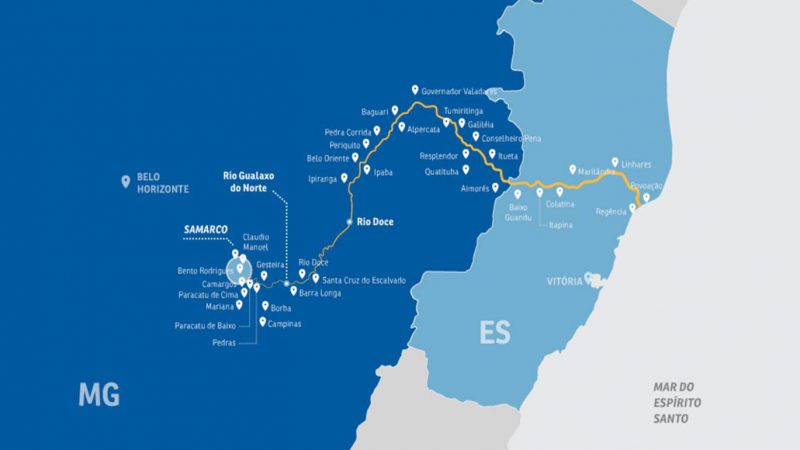Understand the collapse
On November 5, 2015, there was an abrupt rupture of the tailings containment structure at the Fundão dam at the Germano plant in Mariana (MG) operated by Samarco. Unfortunately, 19 people, including members of the community and employees of Samarco and contractors, disappeared. As of June 2016, 18 bodies had been identified and one remained missing. Of the confirmed deaths, 13 were from professionals of companies hired by Samarco, four of residents and one person who visited Bento Rodrigues. All rescue efforts were carried out, and the Company sought to give full support to the families of the victims.
It belongs to the Company’s set of dams, which include the Germano (tailings dam) and Santarém (water dam) structures and the drained stacks of the Germano Cava, the Fundão dam maintained a tailings volume of approximately 55 million Cubic meters, within the limits allowed and licensed by the competent environmental agency – Regional Superintendence of Environment and Sustainable Development (Supram) – of up to 111 million cubic meters. This was the volume licensed when the 920 meter quota was reached, according to data from the Environmental Impact Study (EIA).
In extent and volume deposited, Fundão was the second largest dam of the Company, behind only the Germano dam. Like society, Samarco sought to understand what led to an unprecedented dam failure like this. In particular, according to the last audit carried out in July 2015, in order to comply with federal legislation 12,334 / 2010, decree 416/2012 of DNPM and state legislation DN 87/2005 of COPAM, the Fundão dam was stable.
To identify the causes of the disruption, Cleary Gottlieb Steen & Hamilton LLP was hired by Samarco, Vale and BHP Billiton to coordinate an independent investigation with the support of A board composed of geotechnical specialists. Such geotechnical experts have identified that a combination of several factors led to disruption (access the research result here).
The tailings resulting from the Fundão failure passed over the Santarém dam, used to store water and sediment. There was partial erosion in the Santarém massif, with damage to the part of the structure. The reservoir of the Fundão dam passed by a rapid downgrade, damaging the structures of the Selinha dike and the Sela / Tulipa dikes, side walls of the Germano dam.
A total of 32.6 million m³ of tailings came down from Fundão. The material passed over the Santarém dam, which retained a large part of the tailings. Then, the remaining portion of this material reached Bento Rodrigues – district of the municipality of Mariana (MG) located 8 kilometers away from the Fundão structure.
After passing through the district, the tailings reached the rivers Gualaxo do Norte – when they impacted the city of Barra Longa – and Carmo. Then they reached the Doce River. Upon arriving at the Risoleta Neves hydroelectric plant, known as Candonga plant, part of the tailings was contained in the bus and in the reservoir area of the plant. The plume formed by water and tailings continued its flow through the Doce River, reaching its mouth in the district of Regência, municipality of Linhares (ES), on November 21, 2015.
In total, 10.5 million m³ of tailings were carried beyond the limits of Candonga reservoir, diluting along the Doce River, impacting about 680 km of water bodies in the river basin. The major impact occurred in the first 80 kilometers of the basin; In total, 39 municipalities were impacted in the states of Minas Gerais and Espírito Santo. A considerable number of families lost their homes. Rural properties, which totaled about 2.2 thousand hectares, were flooded, unable to produce.
The tailings plume temporarily affected the direct abstraction of water in the river Doce, compromising the supply in nine cities. Among the municipalities impacted are Governador Valadares (MG) and Colatina (ES), which had the water catchment of the affected river for eight and six days, respectively.
To minimize the impact of the Espirito Santo coast region after the arrival of the plume, Samarco installed barriers in the longitudinal direction, on both sides of the river and islands located in the estuary; this, however, did not prevent the plume to spread.
See the path that the tailings follow, below:

The tailings path
See the material below to find out more about the emergency actions performed by Samarco in the first months after the dam break, as well the focus for managing environmental and social impacts.
You can also download the book by clicking here.
With the signing of the Term of Transaction and Adjustment of Conduct (TTAC) between Samarco and its shareholders and the federal and state governments of Minas Gerais and Espírito Santo, emergency actions are being maintained and expanded as part of the socioeconomic recovery plans and socio-environmental work carried out by the Renova Foundation. The data of socio-environmental and socio-economic programs implemented by the Renova Foundation should be accessed in the entity’s activity report or at www.fundacaorenova.org.



